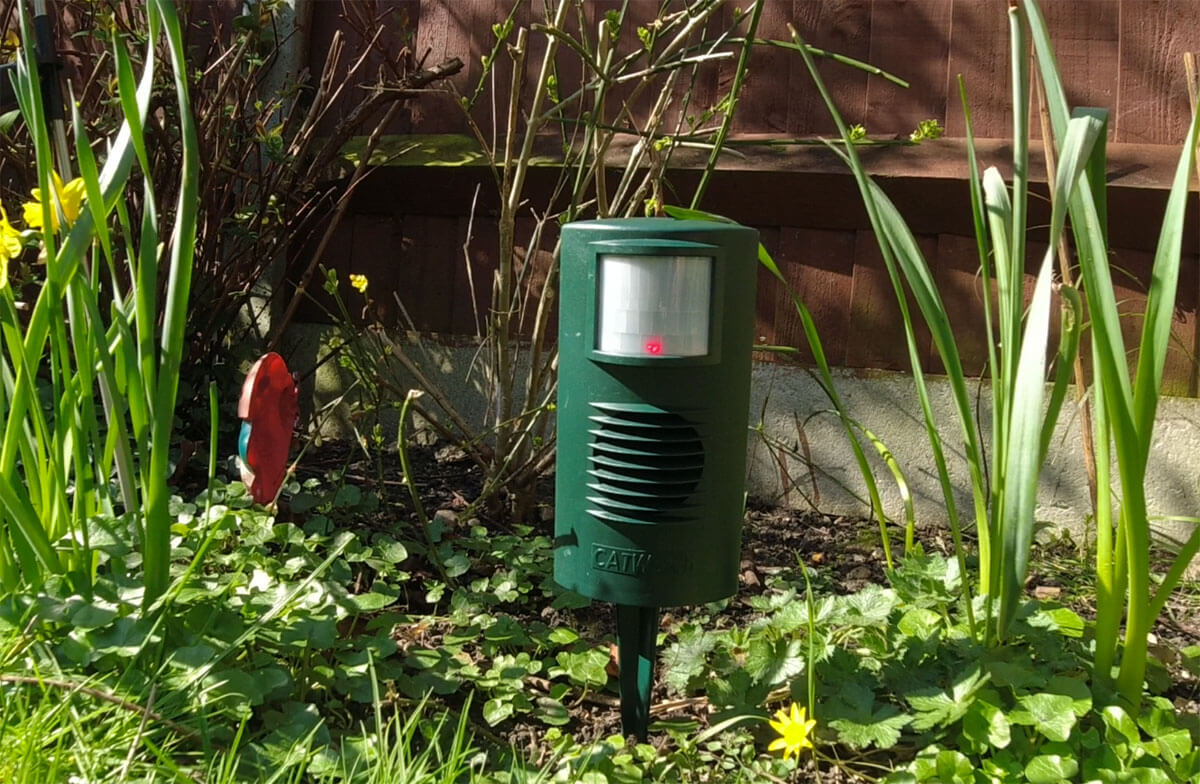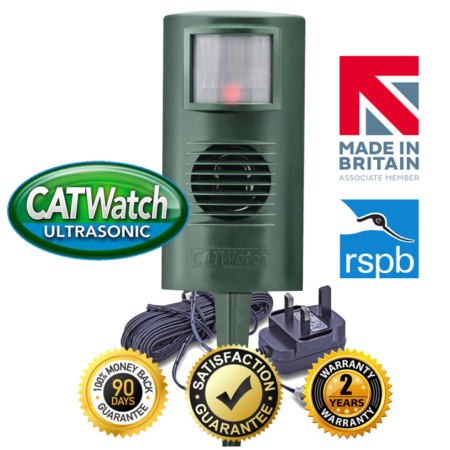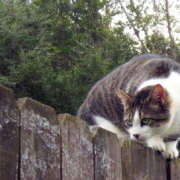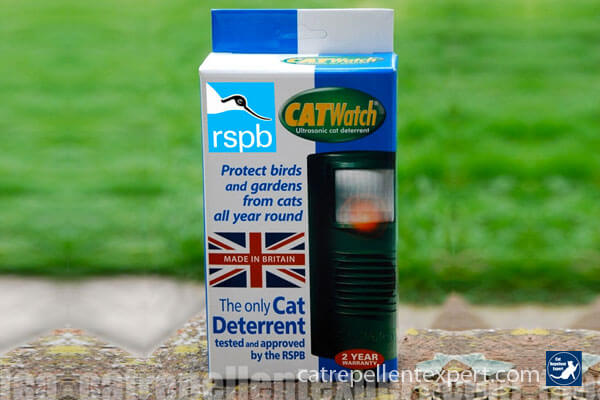Do ultrasonic cat deterrents work?
If you’re looking for a way to stop cats from being a nuisance in your garden, then you may have heard about ultrasonic devices that claim to deter cats by emitting high-pitched noises.
You might be thinking about getting one but you’re not sure as you’ve heard mixed reviews about their effectiveness.
Ultrasonic cat deterrents certainly sound great in theory, as they promise to reduce unwanted cat intrusions into your garden, with minimal effort required from you.
However, do they actually work in practice or are they just a waste of time and money?
In this article, you’ll get an in-depth look at ultrasonic cat repellers, the conclusions drawn from scientific studies and, most importantly, if they can help put a stop to some of the frustrating cat problems in your garden.
Table of Contents
- What exactly is ultrasound?
- Can cats hear ultrasonic noises?
- How do ultrasonic cat deterrents work?
- Have ultrasonic repellers been scientifically studied?
- 5 tips to use an ultrasonic cat deterrent effectively
- 1. Find the cat's entry point
- 2. Install the device correctly
- 3. Use mains power (if possible)
- 4. Don't buy cheap
- 5. Be patient
- What's the best ultrasonic cat deterrent in the UK?
There are an estimated 11 million cats in the UK, so it’s no surprise that you may be experiencing the negative consequences of this country having such a large cat population.
Fouling, digging and killing birds and small mammals are the most common objections to cats trespassing into gardens. Loud, late-night fights, allergies, driving your dog crazy or simply not being a ‘cat person’ are other perfectly valid reasons for wanting to put a stop to cat intrusions.
In your efforts to do something to solve the problem effectively and humanely, you’re clearly interested in finding out if an ultrasonic cat deterrent could work for you.
So, let’s look at precisely that in a bit more detail.
What exactly is ultrasound?
‘Ultrasound’ refers to sound waves with frequencies higher than the upper audible limit of human hearing, which is anything over about 20 kHz. In other words, ultrasound is noise too high-pitched for humans to hear.
We tend to associate ultrasound most commonly with scans during pregnancy, whereby sound waves are used to build a picture of the baby within a mother’s womb. However, ultrasound is used in a wide variety of other ways, such as in submarine radar systems, cleaning car fuel injectors and checking for cracks in bridges.
Ultrasound is common in nature too. Dolphins use it to communicate, bats use it for navigation and some insects use it to avoid being eaten. Ultrasonic noise is reverberating around us all the time, we just don’t realise it because we can’t hear it!
Can cats hear ultrasonic noises?
Cats can indeed hear a very wide range of ultrasonic noises and are constantly encountering and analysing them. There’s a whole world of high-pitched sound out there that we humans are completely oblivious to.
Small mammals, like mice, voles and shrews, all make tiny ultrasonic noises when going about their business. A cat’s hearing is so good that it can distinguish between those creatures and locate them with pinpoint accuracy, all within a split second.
It’s this amazing ability to hear and interpret high-pitched noises that makes cats such efficient hunting machines.
“The hearing range of the cat for sounds of 70 dB SPL extends from 48 Hz to 85 kHz, giving it one of the broadest hearing ranges among mammals. Analysis suggests that cats evolved extended high-frequency hearing without sacrifice of low-frequency hearing.“
Hefner & Hefner, Laboratory Of Comparative Hearing, Kansas University
Of course, not all ultrasonic sounds are created equally. Just because an ultrasonic noise is within a cat’s hearing range, that doesn’t mean the cat will automatically be scared by it.
For comparison in human terms, a kettle boiling and a fire alarm going off are both within our hearing range, but only the fire alarm will cause us concern. This is because the fire alarm is emitted at a particular frequency deliberately designed to instinctively put us on alert.
Similarly, the best and most effective ultrasonic animal deterrents will emit high-pitched noises at a specific frequency, designed to provoke a negative response in the target animal.
By using a well-designed ultrasonic cat deterrent, we can take advantage of the feline sensitivity to certain high-pitched frequencies in order to protect our gardens from cats.
How do ultrasonic cat deterrents work?
An ultrasonic device aimed at deterring cats will usually be a little plastic unit that can be pressed into the ground via an accompanying mounting spike. Popular locations are in a lawn or a flowerbed facing out into the garden. Many of them can also be hung on a fence or wall.
Inside the device, there will be two main components:
- Passive Infrared (PIR) Sensor – A motion and body heat sensor that is activated when the cat moves across the device’s detection zone.
- Speaker – The activation of the PIR sensor triggers the speaker, which emits the ultrasonic noises towards the cat. The noises will continue until the cat leaves the detection zone.
Provided the sounds are emitted at the optimum frequency (20 – 25 kHz), the loud bursts of ultrasonic noise will activate a cat’s fight or flight response.
This results in the cat instinctively wanting to leave the area in order to avoid the unpleasant noise and any potential confrontation. (It’s important to re-state that these noises are inaudible to humans).
Through repeated encounters with an ultrasonic cat deterrent, cats are literally trained to stay away from gardens, or other areas in need of protection. It becomes a behavioural habit as cats start to associate the protected garden with danger and irritation and no longer want to spend time there.
You can use a good quality ultrasonic cat deterrent to keep cats away from lawns, flowerbeds, patios, driveways or anywhere else they’re causing a nuisance. It’s a process that is completely humane and automated, saving you from having to chase off trespassing cats yourself.
Have ultrasonic repellers been scientifically studied?
There have been two particularly prominent academic studies that have subjected ultrasonic cat deterrents to rigorous testing in real-world situations, both of which are highlighted below.
The RSPB study
Because cats are estimated to be responsible for the deaths of approximately 27 million birds every year in the UK, the Royal Society for the Protection of Birds (RSPB) co-funded a scientific study of the UK-made ‘CatWatch’ Ultrasonic Cat Deterrent to see if it improved the situation in gardens.
The study was conducted over a 2-year period, in over 70 gardens across the UK, with the results being published in the peer-reviewed journal, Applied Animal Behaviour Science.
The results of the study proved to be very positive, with the research concluding:
- The CatWatch reduced the probability of a cat intrusion into a garden by approximately 32%.
- The average duration of the intrusions was reduced by up to 38%.
- The magnitude of the deterrent effect appeared to increase with time.
- Cats were learning to avoid gardens with active CatWatch devices, rather than becoming habituated to them.
- The deterrent effect could be increased even further by positioning the CatWatch facing the point at which cats gain entry to the garden.
The results of this study has led to the RSPB adopting the CatWatch as their approved ultrasonic method of humanely deterring cats from gardens.
The Murdoch University study
The School of Veterinary and Life Sciences at Murdoch University, Western Australia, built on the research done by the RSPB’s CatWatch testing and conducted their own, even more sophisticated study of the effectiveness of ultrasonic devices on cats.
Their study, which was published in the peer-reviewed publication Global Ecology and Conservation, was conducted on 78 cats, across a wide range of gardens in Perth, Western Australia. It also used camera monitoring to gain greater insight into the effectiveness of the ultrasonic devices.
The results were even more positive, with the study concluding:
- The ultrasonic deterrents reduced the frequency of incursions into gardens by 46%.
- The duration of incursions was reduced by 78%.
- Ultrasonic deterrents offer a cost-effective, humane option to reduce incursions by unwanted cats.
- Ultrasonic deterrents may not prevent all incursions, but they will reduce the frequency and duration of their visits.
Due to the large cat population in Australia, ultrasonic devices are a common sight in gardens in order to deal with the increasing problem of cat intrusions.
Perth hosts an annual ‘Feral Cat Symposium’ especially to tackle the issue and Canberra has actually gone as far as to introduce cat curfews, placing much greater responsibility on cat owners than in the UK.
5 tips to use an ultrasonic cat deterrent effectively
The scientific research is pretty clear that installing a quality ultrasonic cat deterrent in your garden will help to reduce the frequency and duration of cat visits.
However, there are some additional things you can do to ensure that the device is maximising its effectiveness in your particular garden.
1. Find the cat’s entry point
As mentioned in the scientific studies, if you can find the place where the cat enters your garden, you’re setting yourself up to be much more successful.
Installing the ultrasonic device overlooking the entry point means the cat will trigger the high-pitched noises as soon as it comes into your garden, and likely when it leaves again too.
If the cat’s first and last impressions of the garden are unpleasant, it will learn to associate your garden with the ultrasonic noises much more quickly, ultimately reducing its intrusions and causing less of a nuisance.
2. Install the device correctly
Most ultrasonic cat deterrents can either be pressed into the ground, via an accompanying spike, or hung on a fence or wall.
If using the spike, make sure the device is perpendicular (at 90°) to the ground. Don’t allow it to lean too far forward or backward, as this will limit the detection range of the motion sensor.
If fence or wall-mounting, keep the device low, no higher than 8 – 10 inches (20 – 25cm) off the ground. The motion sensors are usually angled slightly downwards so as to pick up movement on the ground in front of it (i.e. at cat height). Mounting the device at that low height will maximise the detection zone and avoid any blind spots underneath the unit.
3. Use mains power (if possible)
There are some cheap ultrasonic devices available that contain internal rechargeable or solar-powered batteries. These tend to degrade pretty quickly and will not hold enough charge to emit sufficiently loud noises to be effective against cats.
You’ll get far better results if you use a device that enables you to connect up to the mains via an adapter. That will ensure a consistent 12 Volts is going into the unit, emitting loud ultrasonic blasts without the diminishing returns of rechargeable internal batteries.
If you don’t have a convenient plug socket then you can still get excellent results by inserting your own high-quality battery, such as Duracell Alkalines. Try and steer clear of anything else.
4. Don’t buy cheap
There are lots of very cheap ultrasonic devices on Amazon that can look very appealing at first glance. The problem with the really cheap ones is that you don’t always know what you’re actually getting.
Many will claim to repel all sorts of animals without specifying what frequency the units operate at, even though different animals respond to different frequencies. The optimum frequency for cats is between 20 – 25kHz, so that’s the figure you need to look for.
Also keep in mind that your ultrasonic cat deterrent will need to sit outside for months on end and be able to withstand the wet British climate. Cheap devices will naturally use lower-quality components, so their longevity and ability to help resolve your cat problem over the long term is likely to be limited.
Finally, be wary of suspicious 5-star Amazon reviews on cheap ultrasonic products as they’re not necessarily genuine. A common example is a customer purporting to be from the UK but praising the device for getting rid of their terrible racoon/skunk/coyote problem in their ‘yard’. As we don’t have those animals in the UK, the authenticity of the review should be questioned. Proceed with caution.
5. Be patient
The scientific research makes it very clear that ultrasonic cat deterrents become more effective as time goes on. The more a cat encounters the high-pitched noises, the less time it will spend in your garden. The less time it spends in your garden, the less nuisance it will cause.
However, this also means that you need to set your expectations accordingly and accept that the cat won’t necessarily disappear instantaneously. Ultrasound is not a magic wand, but the longer you leave the unit in place, the more effective it will become.
If you’ve ever read mixed reviews on ultrasonic animal deterrents, a lack of patience and giving up before the device has had a chance to have an impact is the most likely reason why.
What’s the best ultrasonic cat deterrent in the UK?
Hopefully, this article has answered a lot of your questions regarding the effectiveness of an ultrasonic cat deterrent and helped provide you with enough information to decide if your garden would benefit from installing one.
The CATWatch Ultrasonic Cat Deterrent
If you’re looking for a low-maintenance way of humanely reducing unwanted cat intrusions in your garden, then consider purchasing a CatWatch Ultrasonic Deterrent.
As highlighted above, the CatWatch comes with the benefit of scientific testing and the backing of the RSPB.
The device is also manufactured in the UK, using high-quality components designed to operate outside and withstand the wet British climate. This means you’ll be able to rely on the CatWatch to provide a continuous, deterrent effect in your garden for the long-term.
Not only does it have the peace of mind of a 2-year manufacturer’s warranty, but you’ll also have the satisfaction of knowing you’re solving your problem with the help of innovative British engineering.
The video below shows you just how easy it is to get the CatWatch set up in your garden in under 5 minutes.
“The CATWatch is proven to reduce the presence of cats in gardens and the deterrent effect increases over time. CATWatch successfully completed a two-year scientific trial conducted by the RSPB to determine its deterrent effect on cats in residential gardens…The research concluded that CATWatch reduces cat intrusions into gardens. The longer the unit is in place, the more effective it is.“
The RSPB
The CatWatch Ultrasonic Cat Deterrent is available in our store priced £69.95 and includes a 12 Volt mains adapter, full operating instructions, 90-day moneyback guarantee, 2-year manufacturer’s warranty and free UK delivery.
Not in the UK?
If you’re in the USA or Australia, then you’ll find the articles below helpful, which include the best ultrasonic devices available in your region.





 Photo credit: pasja1000 - Pixabay
Photo credit: pasja1000 - Pixabay Photo credit: Sheila Shafer-Roberson / Pixabay
Photo credit: Sheila Shafer-Roberson / Pixabay




